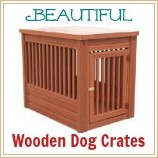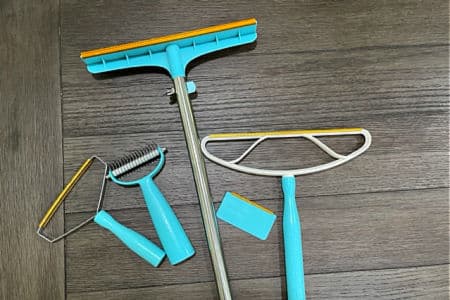FYI: If you buy something through a link on this site I may earn a commission - at NO extra cost to you.
Why Dog Crate Size Is Important
Dog crate size is the most important consideration when you're picking out a crate for your four-legged furball.
Why? Well, it's because the size of dog crate you pick has a big impact on how effective it's going to be as a housebreaking tool, how safe it will be for travel purposes, and how comfortable for containment purposes once housebreaking is a wrap.
This page has all the information you need to make sure that you pick the correctly sized crate for your dog, and situation.
Click on the links directly below to jump straight to a specific section/topic, or scroll down to read the entire article.
- Reasons for using a dog crate
- Dog crate size and housebreaking
- Dog crates for travel purposes
- The right crate size for adult dogs
- Popular dog crate designs and dimensions
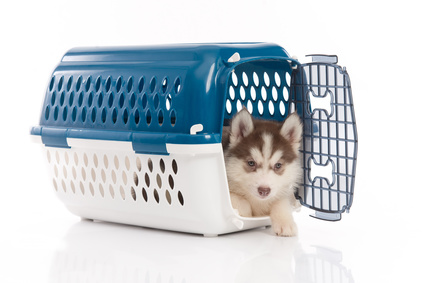
Reasons For Using A Dog Crate
A dog crate is a very versatile piece of equipment and I can't imagine life with dogs without them.
We have several, in different sizes and styles, so that there's always a correctly fitting dog crate for every canine family member, and for every situation.
A Dog Crate Is A Must For Potty Training
The first, and most well-known, reason for using a dog crate is for housebreaking purposes - because crate training is the quickest and most effective way to encourage good potty habits in your new pup.
It works equally well for older puppies or adult dogs too.
Dog crate size is very important when you're using it as a potty training tool.
Using A Dog Crate For Travel
The second most popular use for dog crates is for travel, road trips, plane trips and more.
If your puppy is traveling by air he MUST be contained in an airline-approved crate. Even car travel is safer if your pup isn't loose in the car (even if he's on someone's lap or on the floor).
When you're traveling the size of the dog crate you use is still very important because if it's too big, or too small, for your dog then he could get hurt or injured.
Airlines are very specific about their dog crate size requirements, whether for in-cabin flight or when a dog travels as cargo.
Using A Crate For Containment
The third most common use for a dog crate is containment.
When no one is there to supervise your puppy or dog, putting him in his crate is a smart move.
It can protect your new puppy from hurting himself while exercising his natural curiosity, or to protect your home and furnishings from those puppy teeth.
Or to prevent an older puppy or dog from raiding the garbage, scratching at doors, getting up onto beds/furniture that he's not normally allowed on... even prevent potty 'accidents' in senior dogs.
If Fido is a puppy who is still in the process of learning his potty training skills, then dog crate size is still very important. If your pet is an older, or fully housebroken dog, you can choose size based more on comfort than practicalities.
Dog Crate Size - For Housebreaking
The size of dog crate you pick out is most important when you're going to be using it to housebreak your puppy or dog.
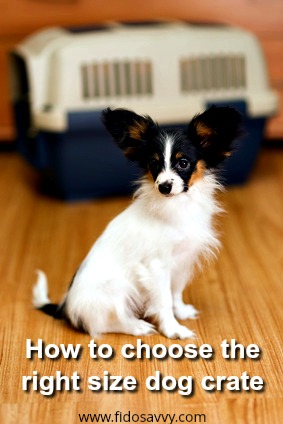
Crate training works because dogs are naturally 'den' animals and they instinctively try not to mess where they sleep.
When his crate feels like a small den, your puppy will be be motivated to practice some bladder/bowel control and 'hold it' until you let him out.
When you take him straight to his designated 'potty spot' it kick-starts the right habit of eliminating where YOU want him to.
BUT if his crate is too big, your pooch will think that there's plenty of room for a sleeping area and a toilet area and won't feel the same urge to wait for you to let him out before he pees or poops.
This obviously makes potty training your pup much more of a challenge.
How big should a puppy crate be?
Well, let's start by
stating the obvious... it depends on the size/breed of puppy you have!
Large and X-large breed puppies are usually significantly bigger than small breed adult dogs, so an extra-small crate will not work for an 8 week old Great Dane pup, not even for your average Labrador Retriever either.
Now with that said, here's a 'rule of thumb' that will help you decide which dog crate size is right for your pet....
Your pup should be able to stand up, lie down and turn around inside the crate without touching the sides.
That
also means when he's sitting down his head should have 'clearance
room'. Oh, and don't forget that his tail doesn't want to be completely bunched up
at the back either!
If you are buying at your local petstore and your pup has had all his puppy vaccinations and is safe to go out in public, then you can have him try out the different dog crate size options and see which ones work and which don't.
This is obviously a pretty straightforward way to 'get it right'.
But, a lot of the time you might be buying a crate without the hands-on (or paws-on) help of your pup for a number of reasons.
Maybe you haven't actually brought him home yet and are getting his 'stuff' all sorted out ahead of his arrival, or perhaps he's only had one or two sets of puppy shots (or none even) so far and isn't fully protected from contagious dog diseases, so it's not a good idea to take him out and about.
Or perhaps you're shopping online where the selection and prices are better.
puppies can outgrow their crate quickly....
Puppies grow really fast, and a crate that is the right size now won't be a good fit in a few short months.
When you're buying a puppy crate, don't make the first one an expensive or designer model, Instead, either save your dollars until your pup is fully housebroken, and closer to his adult size or choose a wire crate which has a divider panel which can be used to reduce the available space and adjusted as your puppy grows.
No matter what the reason, if your pup isn't available to try crates on for size, you can take his measurements with you, here's how.....
The first is to measure his height and length.
You'll want his dimensions from nose to about half way down his tail, and from the floor to the top of his head. Then add between 4 and 6 inches to each measurement. This will give you the approximate size of the crate that your pup needs at this point.
It's also helpful to have at least a rough idea of how much your pet weighs.
Dog crates should be labeled with their length, width and height and also often include information on the weight of dog/puppy that they've been designed to hold... some even give you advice on which they breeds might fit.
But remember every puppy is unique and might vary a little, or sometimes a LOT, in size from other pups of the same breed/age.
If you aren't taking your little guy shopping with you, or are ordering online, here are some dog crate size guidelines to help you pick the right dimensions.
Dog Crate Size For Travel
When you're picking out a crate to use for transporting your puppy or dog by air, you need to be careful to get it big enough to be comfortable (and meet the regulations), and yet small enough that he won't by thrown around while in motion.
Airline regulations require that the crate be tall enough for your pet to stand up straight and in a 'natural position'.
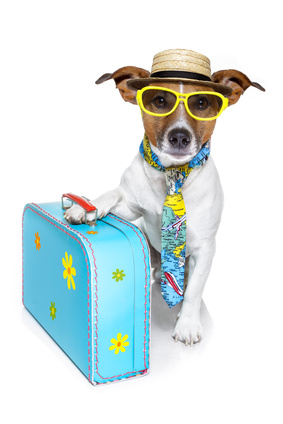
This means he shouldn't have to duck his head to stand, or to go in or out of the door, and his ears shouldn't hit the roof of the crate.
It should be long and wide enough for him to turn around, sit, and lie down - again 'in a natural position' which means he shouldn't HAVE to curl up in a tight ball to sleep... although of course he may choose to do that anyway :)
This is when the labeling which indicates which breed of dog a crate is suitable for can come in useful. If you have an adult dog it will give you a place to start, but do remember all dogs are different - even those of the same breed.
Your Labrador Retriever, Yorkie or Australian Shepherd isn't necessarily the same size as any, or every, other example of his breed!
So always either take your dog with you when choosing a crate, or have his measurements with you to double check against the crate's dimensions.
For airline travel, crates are referred to by a number rather than a size. Here's a quick guide to which size each number generally corresponds to:
- X-Small - '100 Size' Kennel
- Small - '200 Size' Kennel
- Medium - '300 Size' Kennel
- Large - '400 Size' Kennel
- X-Large - '500 Size' Kennel
- Giant - '700 Size' Kennel
Because each manufacturer makes products of slightly different dimensions, please don't assume that your 'Small' crate is definitely a '200 size' model.
Always check with the airline well in advance of your travel date so that you can be absolutely certain that you have it right.
2PET Cabin Travel soft sided crate and the Pets Go2 Expandable Pet Carrier are designed to fit under an airline seat and allow you to take your small dog, puppy (or cat) in the cabin with you, rather than traveling in the hold.
For car travel, you want to stay with similar dog crate size recommendations as you want Fido to be safe and protected from sudden stops, turns etc.
If your dog is an adult and his regular crate is very roomy, you may want to consider buying a smaller one just for travel purposes. Better safe than sorry right?
What Size Crate Is Best For An Adult Dog?
The first question to ask before I can answer that is... 'is your dog house trained?'
A dog who is already potty trained and knows to eliminate outdoors (or perhaps on pee-pee pads or in a doggie litter box) is very unlikely to pee or poop in his crate.
It simply won't occur to him - unless you've left him for a very long time, or he has separation anxiety.
So this means that you can choose a dog crate whose size is more related to comfort than to discouraging elimination.
In this situation I'd recommend getting one that's big enough for your pooch to stretch out and move around in, especially if he's going to be in it all day while you go to work or stuff like that.
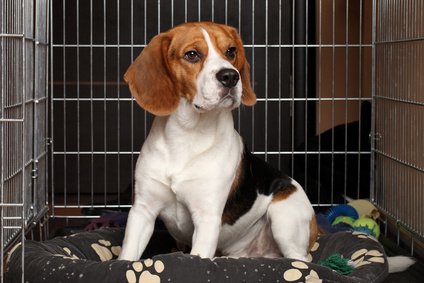
Some dog breeds LOVE to chew, and even as adults they have a tendency to always want something in their mouths.
A few sturdy chew toys are wonderful crate companions for puppies and adult dogs.
Others grow out of the teething stage and never give destruction-by-dental-work another thought.
If your dog is in the latter category then extra room for a nice, soft, cushy dog bed is also a good idea.
BUT.. if your adult dog isn't fully housebroken, you will need to follow the puppy crate size guidelines I gave earlier on this page.
Dog Crate Sizes & Dimensions
Dog crates are available in these sizes: X-Small; Small; Medium; Large: X-Large; XX-Large; Giant
Each manufacturers products are often of slightly different dimensions, and there can be anywhere between 1 and 3 or 4 inches difference between two crates that are both labeled as the same size (ie Small, Large or whatever).
Also, not ALL ranges will come in the X-small or XX-Large/Giant options and one brand's 'X-Large' may be another's XX-Large or Giant, you need to look closely at the labels!
Here's a quick look at the average dimensions and weight guidelines for the set of dog crate sizes given above
(Please note that these are the OUTSIDE measurements, the space inside is a little smaller):
X-Small - 22"L x 16"H - 1 to 10lbs
Small - 24"L x 20"H - 11 to 25lbs
Medium - 30"L x 24"H - 26 to 40lbs
Large - 36"L x 27"H - 41 to 70lbs
X-Large - 42"L x 31"H - 71 to 90lbs
XX-Large - 48"L x 33"H - 91 to 150lbs
Giant - 53"L x 45"H - 100lbs plus
Although many crates will also give you info. on the breeds each size is suitable for, this is really only useful when you're trying to figure out what dog crate size you need for an adult or almost-fully-grown dog.
One that would fit an adult dog of any breed (with the exception perhaps of the tiny, toy breeds such as chihuahuas) is going to be much too big for the same breed as a 'baby'.
When you're shopping for a puppy's crate, matching the crate's size to your puppy's current length, height and weight is the only way to make sure you choose one which works.
But, if you are looking to buy a crate for an almost-grown or adult dog, here's a rough guide to which size of breed the standard crate sizes will fit......
X-Small or Small:
Yorkshire Terrier, Chihuahua, ShihTzu, Miniature Dachshund, Min Pin, most 'Teacup' & 'Toy' breeds.
Medium:
Cocker Spaniel, King Charles Spaniel, Beagle, JRT, Miniature Poodle, Standard Dachshund, Miniature Schnauzer.
Large:
Labrador, Golden Retriever, Boxer, Pitbull Terrier, Bulldog, Husky, Border Collie
X-Large:
Rottweiler, German Shepherd, Great Pyrenees, Amstaff, Akita
Giant: English Mastiff, Cane Corso, St. Bernard, Giant Schnauzer, Newfoundland
But don't forget not all dogs of the same breed are the same size! Don't forget to use your own dog's measurements as guidelines.
Need a crate for an extra large dog?
If so I might be able to save you some trial and error!
I have a large, adult male German Shepherd and finding a crate big enough for dogs like this can be a bit hit and miss. Originally he had a plastic crate, then I bought a very expensive crate that was also a piece of furniture, unfortunately he broke out of that when someone came to the door and it was un-fixable!
So, I decided to go with a wire crate and found the perfect one for a great price so thought I'd share so that anyone else in the same situation could save some time and money.
Here is a pic of the crate, and as Dax is just over 100lbs and a big dog I added a pic of him in it for reference.
Also, I bought the crate cover to give him some privacy (and cut down on the dust and hair he 'floofs' all over the place at all times).
We have several of the crate pads that he uses as beds elsewhere. Again, not too expensive but he finds them very comfy. Amazon links to all products included below.
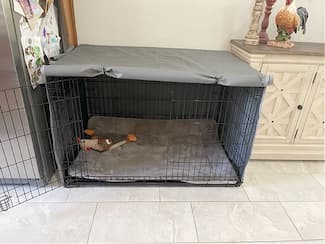
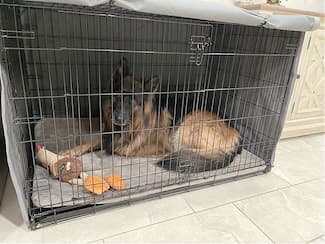
- Midwest Homes 48" wire crate with double doors
- Explore Land 48" dog crate cover
- JoicyCo 48"x30" dog bed/crate pad
In the event you're looking for a new toy to keep your dog company in his crate, thought I'd share Dax's favorite GoDog Checkers Skinny Rooster (large size).
Warning: this toy is NOT indestructible, and if you have a puppy (or an adult dog who still likes to chew up toys) this is not for him/her. Dax just carries this as his 'lovey' and never chews it up. He's on about his twentieth rooster though because they get dirty from being carried and loved on, and after a couple of washes I just replace them!
Dog crates don't just come in a range of sizes of course. There are also a LOT of different styles too. Not every type of crate is right for every puppy, or home.
Why not take a closer look at the variety of styles, models and materials used in the most popular dog crates, by clicking on any of the thumbnail images right here....
Crates aren't cheap (especially the larger sizes or more decorative models) so it's a good idea to make sure you know what style you need before you buy.
Check out my guide to choosing the perfect crate by clicking on the banner below, it could save you a lot of time and money....
you might also like...
- Home
- Best Dog Crate
- Dog Crate Size
FTC Disclosure: Some pages on this site contain affiliate links. I may earn on qualified purchases.




